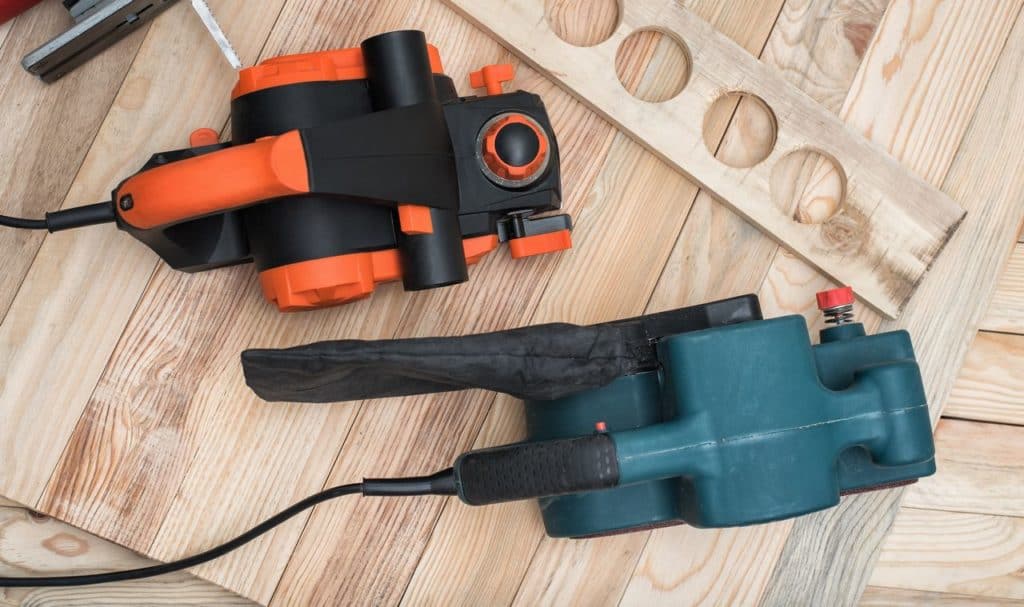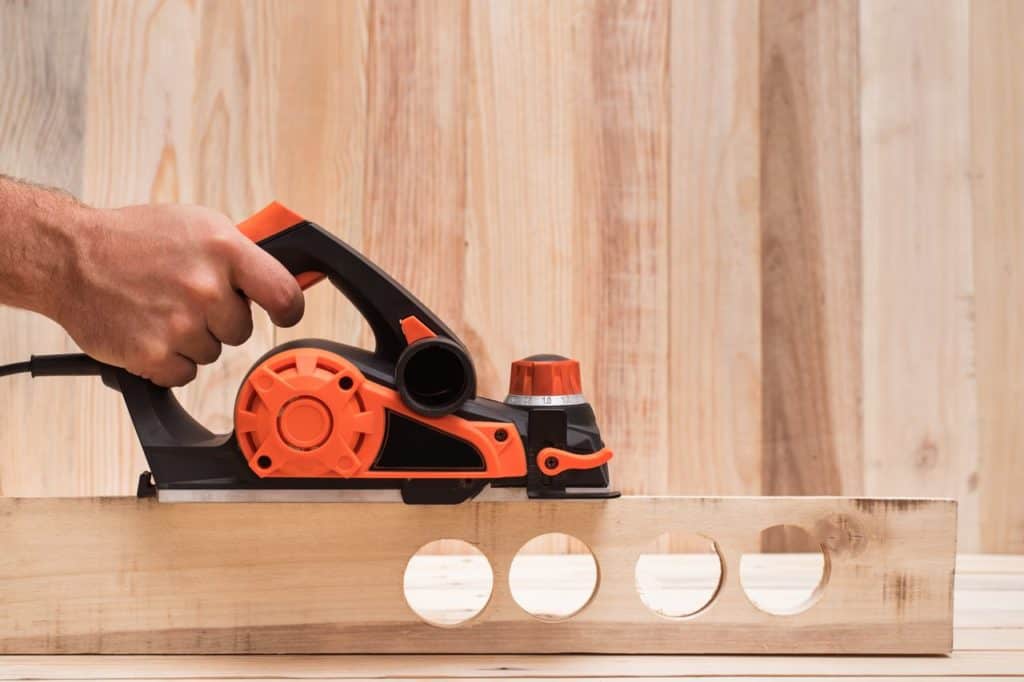
Planing and Sanding are the two common methods of removing excess wood from a job, reducing the thickness of a work piece and finishing the surface smoothly.
In this article, we are providing an overview of both techniques, their pros and cons as well as the tools needed.
Planing
What Is Wood Planing?
The term planing refers to the process of removing surface layers of wood using a plane tool. Planing wood can be done two ways using:
- a traditional hand plane, or
- a more modern rotary plane power tool.

Hand Planes
Hand planes come in a variety of sizes for different jobs but they all serve similar purposes. The three basic sizes are:
- Block Planes for removing large amounts of wood,
- Smoothing Planes for medium duty work, and
- Jointing Planes for finer work and for finishing.
The GreatNeck C4 Bench-Jack Plane (9 Inch)
Find this one and other planes on Amazon.
These hand planes consist of a flat bed with a narrow opening part of the way along the bed and having a blade protruding through the opening. The plane is then pushed along the wood and the protruding blade cuts off very thin slices, or shavings of wood each time the plane is used.
Power Tools for Planing
Electrically powered planes are available in two forms:
- Bench planes and
- Handheld electric planes.
Bench planes are tools where the plane cutting tool is protruding slightly through a slot in a special workbench. The wood to be planed is moved across the cutting blade often by use of a side fence to pass it over the blade in a straight continuous motion.
A handheld electric plane
(Makita 3-1/4 Inch Planer)
A benchtop planer
(WEN 13 inch planer)
Handheld electric planes are also common and more portable than the bench type (source). They can be used on most carpentry work in a similar way as a traditional handheld plane can.
How Can Wood Be Planed?
Planing wood requires either a manual or a power plane that is used to process the wooden surface.
It is best done when going along the grain of the wood. This usually produces the best and smoothest finish. Planing against or across the grain is generally not recommended. It requires more skill and effort to create a good finish and can often take unsightly chips out of the wood.
You can watch this video for further details.
Sanding
What Is Wood Sanding?
Sanding wood using traditional sandpaper is ideal for removing small surface imperfections or unwanted coatings on the wood. Sanding is also an alternative to planning especially with pieces of intricate wood that may not be possible to plane in the traditional way.
How Can Wood Be Sanded?
Sanding can be done manually or by the use of an electric sander. When sanding either by hand or by using a power tool, try to always sand following the grain of the wood and you will find you have a smoother finish with less sanding scratches visible.
Sanding Wood by Hand with Sandpaper
Sandpaper is available in many different grits or coarseness. A low numbered grit, for example, 80 is coarser than a higher grit number, perhaps 150 or 180.
When starting to sand, start with low grit sandpaper to remove the deepest imperfections or scratches in the wood. As the sanding progresses and the wood becomes smoother, swap sandpaper grit sizes to higher numbered grits to remove less wood and start creating a nice and smooth finish
If manual sanding by hand with sandpaper is preferred, the use of a sanding block should be considered. This is a small piece of wood or other hard material that the sandpaper is wrapped around and held tight to when sanding to ensure an even sand and flat surface.
Sanding Wood with an Electrical Sander
Electric sanders have a mechanism to hold the sandpaper secure while using the sander. This might be a set of wire clips or Velcro backing on the sander that holds special Velcro backed sandpaper.
A Bosch 2.5 A 5-inch palm sander – a popular random orbital sander
There are two types of electric sander, Rotary and Vibrator type. For smooth finishes, the vibrator type will leave fewer visible scratches than the rotary, especially when using low grit sandpaper.
Common types of sanders for wood finishing are:
- Orbital sander,
- Random orbital sander,
- Mouse and palm sander,
- Belt sander, and
- Grinders with a sanding attachment.
Click on the above links to learn more about the respective sanders. For details on the sanding and abrasion attachments, read this comparison.
Sanding vs Planing of Hardwood Floors
There is nothing quite like bringing out the detail and beauty of an old hardwood floor than by planning or sanding it to remove unwanted scuffs, scratches and years of paint and varnish.
You might wonder whether a hardwood floor should be planed or sanded. The answer depends on the individual situation: If you need to remove a significant part of the surface, e.g. for the restoration of old and substantially worn-down hardwood floors, you will likely want to use a planer for the harsh removal part. For a fine finish or refinishing work, a sander is generally the better choice. It can be used with coarse sandpaper first, followed by sandpaper with an increasingly finer grit.
Note that a planer normally removes significantly more material than a sander. You should therefore make sure that an existing hardwood floor is thick enough to stand it.
Specialized belt type floor sanders and planers are available on the market. If you are planning on renovating many hardwood floors or using it for different types of projects, check these belt sander reviews. Otherwise, hiring is probably the most cost-effective way to do the job.
How to Plane or Sand a Floor?
Before you start sanding or planing, be aware that you will be producing an awful lot of dust, depending on the floor area size so it is probably best to seal the area to contain the dust from nearby areas. You will need to protect yourself and suitable face mask and protective glasses should be worn along with protective clothing that will end up getting very dusty.
After you have exposed the floor from any old carpets of floor coverings, inspect the floor and repair any loose boards or damaged areas. Check across the floor for floorboard nails and make sure they are all seated well into the wood. A stray nail may damage a plane blade or destroy a sanding belt if not seated below the surface of the floor. So it is well worth taking a bit of care on the preparation to avoid disasters later.
Excessively worn or dented floors may require several sweeps of a floor planer to smooth them out. Don’t try to take off too much wood on each sweep. After planning the entire floor, check again for any nails that may have come loose or are protruding before continuing.
You may be wondering why it is necessary to use a belt sander or floor planer if you have a relatively small floor to renovate that appears fairly flat and smooth already. Well, you can try using a standard woodworking hand scanner but it is very likely the job will turn out to be much longer than you had first imagined, or the sander might not be robust enough to cut deep enough into the wood to remove all that ugly wear and tear you want to get rid of. A belt floor sander is much more robust and can be operated whilst standing as opposed to small handheld sanders.
The final sweep of the floor is probably best done using a belt-type floor sander to produce the best finish prior to varnishing.
Read our detailed step-by-step guidance for further details on how to sand a hardwood floor.
Conclusion
Planing and sanding are wood finishing techniques that can be performed manually or with power tools. While planing tends to remove more surface material, sanding is mostly used for finishing a woodworking project or a hardwood floor. Especially finer grits of sandpaper produce a smoother result while removing significantly smaller amounts of material from the surface.
If you need to finish wood including sanding, visit our section on sanding for step-by-step instructions and an overview of the different sanding tools that you can use.





